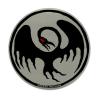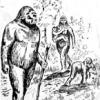Beg to differ. I've seen them myself, the ones displayed in the Mark Twain Museum in Virginia City, Nevada in the late 60's and 70's. There have been people who have examined a few bones from the many taken from the Lovelock Cave and concluded that those few were within the human range of size. Their conclusion, therefore, without examining more, were that all of the remains were normally sized and that the original excavation report was in error. Revisionist archeology. This is the sixth or seventh thread on this topic since I've been a member. I've posted quite a bit on it in the previous threads, including the information provided to me by the Nevada Historical Society.
Here's what I posted in the Conspiracy Theory thread just two weeks ago.
"There have been multiple threads on this and I find the search engine frustrating because the thread i'm looking for always seems to be omitted from the results.
Bottom line: When the remains were found, there were quite a few of them. The find was split up and various groups grabbed portions of the find. Most of the remains have since been lost or destroyed. The Mark Twain Museum in Virginia City, Nevada used to have three of the mummified skeletons on display from the late 60's to the early 80's. I viewed them several times. A prominent uranium miner in Reno had one of the skulls, which his son (a geology student at UNR at the same time as my father) used as an ashtray.
The mummified remains were a foot or two taller than the average person today and were probably more than three feet taller than the average contemporary Paiute.
The remains were taken from the Mark Twain Museum at some point by the BLM, and the last I heard some of them are now held by the Hearst Museum in California. Whether or not this is the set taken from the Mark Twain Museum, or other remains from the site, I can't say.
I did visit the Nevada State Historical Society and they later sent me articles detailing the archeological investigation of the site. Excavation of the layers revealed that the cave had been occupied by people using atlatls for centuries. Both darts and atlatls were found. Arrows were found in the topmost layer, but no bow fragments. There was evidence of a fire in the topmost layer, so overall the evidence backs up the Paiute legend of trapping them in the cave, lighting a fire at its mouth, and firing arrows into the cave as it burned.
The giants were named the stick-thrower people. This is consistent with the use of atlatls. Why would a people use atlatls when other groups were using bows for centuries? The most logical answer to me is that they were, indeed, taller as a race. Short bows are easier to make than longer bows from available materials, unless you have specialized high strength, high tensile woods. For a people with longer arms, and proportionally greater strength, the atlatl would have remained a more powerful weapon than the short bows used by Native Americans, with greater distance and felling power.
There are published articles that ostensibly debunk the original archeological report, but they examine a very limited number of bones from the remains and then insinuate that the original investigator was mistaken.
Given that a 7'-8' tall race of red haired people (this was the size of the remains I viewed) did, in fact, exist in Nevada, I pay a little more attention to reports of mound excavations in the Midwest that describe similar remains. It is clear that a race of such people did exist and that the race, as a whole, has gone extinct. It is not a stretch to assume that they were not confined to Nevada."



